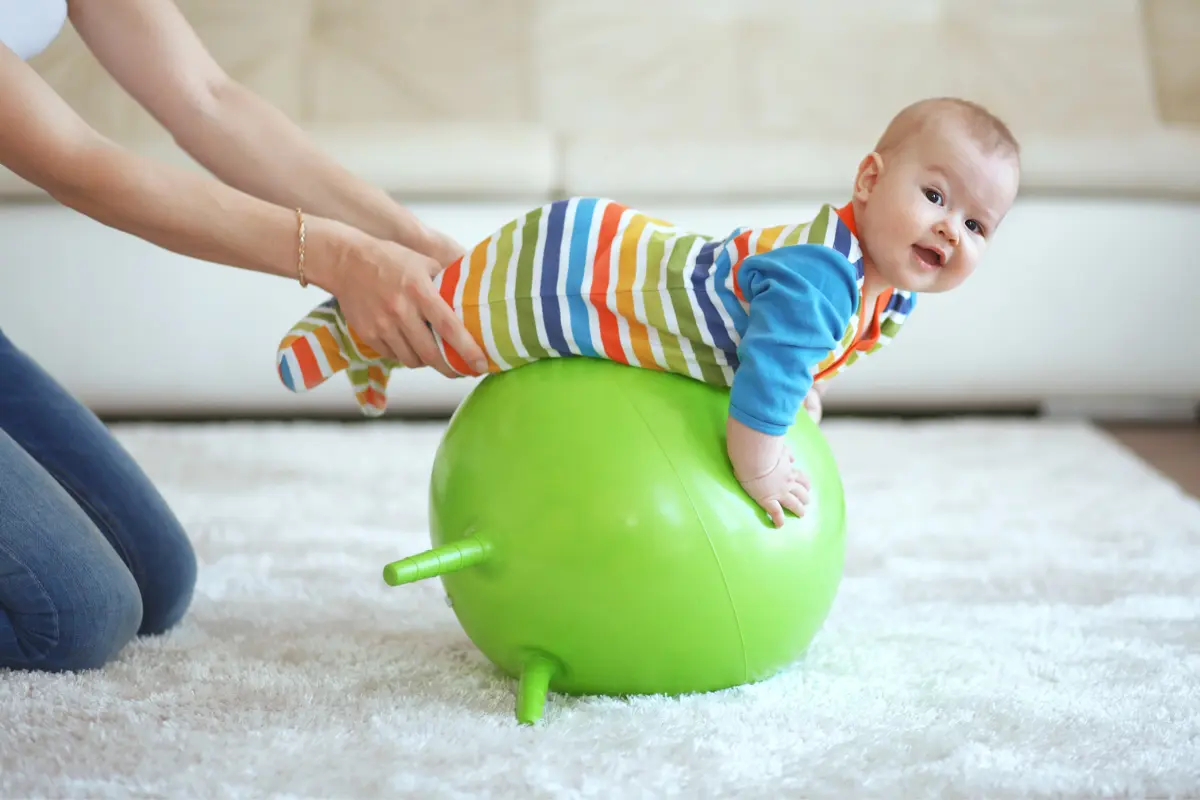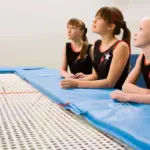When you think about gymnastics, you might imagine teenagers or adults performing flips, vaults, or graceful routines on the balance beam. However, gymnastics is a versatile sport, and there are ways for even toddlers, as young as one-year-old, to get involved.
At this age, the focus is on gentle exploration, allowing your toddler to move, climb, balance, and discover their body’s abilities without pushing them into formal training too soon.
What Can 1-Year-Olds Do in Gymnastics?
While a 1-year-old won’t be performing advanced gymnastics routines, there are plenty of age-appropriate activities that benefit their growth. These early experiences build strength, coordination, confidence, and body awareness, all through simple, playful movement.
1. Tummy Time & Rolling
Rolling is one of a baby’s earliest “gymnastics” skills. Tummy time remains essential at one year old because it:
- Strengthens neck, back, and core muscles
- Helps babies stabilize themselves for crawling and early walking
- Encourages healthy posture and coordination
In a gym environment, soft mats make tummy time more fun while providing a safe place to practice rolling and wiggling.
2. Bouncing & Gentle Jumping
Many toddler-friendly gymnastics programs include soft, supported bouncing activities. Your 1-year-old might:
- Bounce lightly on a springy mat
- Try tiny supported jumps on a mini trampoline
- Feel rhythmic up-and-down movement while holding your hands
These movements promote balance, leg strength, and early coordination, without any pressure to “jump high” or perform tasks they’re not ready for.
3. Crawling & Climbing
Crawling is one of the best full-body exercises for babies. In early gymnastics:
- Low mats
- Soft tunnels
- Foam blocks
- Small padded steps
encourage safe, confidence-building climbing and crawling. These activities boost spatial awareness, arm and leg strength, and early problem-solving.
4. Balance Activities
Balancing is a new skill for most 1-year-olds. That’s why early gymnastics keeps balance challenges very simple, such as:
- Walking across a wide, low beam (with your hands supporting them)
- Standing on a soft balance pad
- Trying slow, controlled steps on stable surfaces
These early balancing moments build core strength and coordination without overwhelming them.
5. Stretching & Flexibility
Toddlers don’t need deep stretching, but gentle, playful movement helps:
- Improve flexibility
- Support natural range of motion
- Increase body awareness
Stretches might involve waving arms, reaching up, bending to touch toes, or moving legs in soft, guided motions, always slowly and comfortably.
Five Simple Gymnastics Exercises for Your 1-Year-Old
Introducing gymnastics to young children can be a delightful and rewarding experience, offering a mix of fun, discovery, and developmental benefits. Here are five simple, age-appropriate gymnastics exercises that will engage your 1-year-old in a fun and educational way.
1. Stretchy Fabric Hammock Relaxation
Starting with something calming helps your toddler ease into movement. A soft, stretchy fabric hammock creates a cozy, cradled feeling that mimics being held. As your child gently sways, they experience soothing motion and new textures, which support early sensory development.
The rocking movement also introduces basic balance and body awareness. And for many little ones, this secure “nest” becomes a favorite spot to relax.
Safety Tip: Keep the hammock low and always supervise while your child is inside.
2. Swing and Sway on a Nest Swing
Swinging is simple, fun, and incredibly beneficial. A nest swing offers a soft, stable surface where toddlers can enjoy gentle back-and-forth motion. This movement stimulates the vestibular system, which plays a key role in balance and spatial awareness.
As your child swings, they learn how their body feels in motion and begin to build confidence in new types of movement—something that will support future gymnastics learning.
Safety Tip: Keep the swing close to the ground and stay within arm’s reach.
3. Hanging Around on Low Bars
A low bar is a wonderful way to introduce your child to basic hanging skills. With your hands supporting them, your toddler can practice gripping the bar and gently lifting their weight. This strengthens their shoulders, arms, and hands, while also building early upper-body coordination.
Even a few seconds of hanging can feel like a big accomplishment at this age, helping them feel proud and capable.
Safety Tip: Ensure the bar is sturdy and placed over a padded mat for soft landings.
4. Mini Climbing Wall Adventure
Climbing is a natural part of toddler development, and a fantastic workout for the whole body. A mini climbing wall with large, colorful holds encourages little ones to reach, stretch, and problem-solve.
As your child chooses where to place their hands and feet, they’re building coordination and early decision-making skills. Every small “reach and step” helps develop confidence, strength, and independence.
Safety Tip: Supervise closely and use thick mats underneath the climbing area.
5. Gymnastics Rings for Tiny Hands
Small gymnastics rings set at toddler height can provide a fun challenge. With your support, your child can grab the rings, pull gently, and experience the feeling of hanging. This builds arm, shoulder, and core strength in a safe, playful way.
Even brief holds offer big developmental benefits, and your toddler will love the sense of accomplishment.
Safety Tip: Keep rings low, assist with both hands, and always provide cushioning on the floor.













